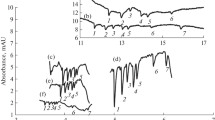Summary
Almost all modern analytical methods have been used in food chemistry. Chromatographic methods are of particular importance, as they are suitable for most qualitative and quantitative determinations. Further developments of liquid-chromatographic systems, especially pre- and postcolumn derivatization, can be applied to reducing and nonreducing carbohydrates and their derivatives. An additional useful technique is the capillary gas chromatography of thickening agents and stabilizers. Enzymatic methods, too are of considerable importance, as they permit specific measurements of carbohydrates in heterogeneous foods and biological samples.
When comparing thin-layer and column chromatography a real partnership is revealed, because each method has its specific preferences. In future, several other methods will be introduced in carbohydrate analysis. These will certainly include methods based on NMR, IR and NIR, and also enzyme electrodes and enzyme immunoassays. The enzymatic determinations of carbohydrates will in future be optimised by improved semi-automatic systems so that their use in routine analysis can be extended.
Zusammenfassung
Als Folge der vielschichtigen Problematik sind fast alle modernen Methoden der Kohlenhydratanalytik im Bereich der Lebensmittelchemie eingesetzt worden. Dabei kommt den chromatographischen Verfahren besondere Bedeutung zu, weil mit diesen die qualitativen und quantitativen Bestimmungen in den meisten Fällen realisiert werden können. Mit der Weiterentwicklung von flüssigkeits-chromatographischen Systemen, insbesondere der „pre“ und „postcolumn-Derivatisierungen“ zur Verbesserung der quantitativen Messungen können sowohl reduzierende als auch nichtreduzierende Kohlenhydrate und ihre Derivate erfaßt werden. Eine zusätzliche wichtige Erweiterung stellt die Anwendung der Capillar-GC zur Bestimmung von Dickungsmitteln und Stabilisatoren dar. Auch der Einsatz enzymatischer Bestimmungsmethoden ist von erheblicher Bedeutung, weil auf diese Weise spezifische Messungen von Kohlenhydraten in heterogenen lebensmittelchemischen und biologischen Proben möglich sind.
Eine Gewichtung der einzelnen analytischen Möglichkeiten in bezug auf Dünnschicht- und Säulenchromatographie macht deutlich, daß eindeutig eine Partnerschaft gegeben ist, weil jeder Methode spezifische Präferenzen zu eigen sind.
Langfristig wird eine Reihe weiterer Bestimmungsmethoden in die Kohlenhydratanalytik von Lebensmitteln eingeführt werden. Hierher gehören sicherlich Bestimmungen auf der Basis von NMR, IR und NIR sowie die Anwendung von Enzymelektroden und Enzymimmuno-Assays. Die enzymatischen Kohlenhydratbestimmungen werden langfristig durch Einsatz verbesserter halbautomatischer Analysensysteme soweit optimiert, daß der Einsatz in der Routine-Kontrolle erweitert werden kann.
Similar content being viewed by others
Literatur
Scherz H, Mergenthaler E (1980) Z Lebensm Unters Forsch 170:272–275
Mergenthaler E, Schmolck W (1974) Z Lebensm Unters Forsch 155:193–197
Preuß A (1982) Dissertation Münster
Endean MG (1974) The detection of thickeners, stabilizers, and gums in foodstuffs. The British Food Manufacturing Industries Research Association (Hrsg.) Scientific and Technical Surveys No. 82
Mehrens H-A, Reimerdes EH (1983) GIT — Suppl Chromatographie 6:61–67
Voelter W, Bauer H, Hofmann WU (1974) GIT Fachz Lab 18:331–334
Hough L, Jones JVS, Wüsteman P (1972) Carbohydr Res 21: 9–24
Reimerdes EH, Gottschick W (1981) Lebensmitteltechnol 9: 402–406, 466–470
Schauer R (1977) Acta Histochem, Suppl 18:25–44
Bergmeyer HU (1974) Methoden der enzymatischen Analyse, Bd. I u. II. Verlag Chemie, Weinheim
Consden R, Gordon AH, Martin AJP (1944) Biochem J 38:244–248
Cramer F (1950) Angew Chemie 62:73–78
Craig L (1950) Anal Chem 22:1346–1347
Rees WR, Reynolds T (1958) Nature 181:767
Bourne EJ, Lees EM, Weigel H (1963) J Chromatogr 11:253–256
Ghebregzabher M, Ruffini S, Monaldi B, Lato M (1976) J Chromatogr 127:133–137
Gauch R, Leuenberger U, Baumgartner E (1979) J Chromatogr 174:195–201
Martin AJP, Janus AT (1952) Biochem J 50:679
Albersheim P, Nevins DJ, English PD, Karr A (1967) Carbohydr Res 5:340–347
Sweeley CC, Bentley R, Makita M, Wells WW (1963) J Am Chem Soc 85:2497–2499
Zürcher K, Hadorn H (1974) Deut Lebensm Rundsch 70:425–428
Zürcher K, Hadorn H, Strack Ch (1975) Deut Lebensm Rundsch 71:393–397
Preuß A, Thier H-P (1982) Z Lebensm Unters Forsch 175:93–100
Preuß A, Thier H-P (1983) Z Lebensm Unters Forsch 176:5–11
Varma R, Varma RS, Wardi AH (1973) J Chromatogr 77:222
Zürcher K, Hadorn H, Strack Ch (1975) Mitt Geb Lebensm Hyg 66:92–94
Bauer H, Voelter W (1976) Chromatographia 9:433–439
Khym JX, Zill LP (1952) J Am Chem Soc 74:2090–2094
Kesler RB (1967) Anal Chem 39:1416–1422
Shukla KA, Scholz N, Reimerdes EH, Schauer R (1982) Anal Biochem 123:78–82
Reimerdes EH, Rothkitt K-D, Schauer R (1984) Fresenius Z Anal Chem 318:285–286
Reimerdes EH (1982) Lebensmittelchem Gerichtl Chem 36:118–120
Reimerdes EH, Gottschick W, Scholz N (1982) Int Dairy Congress, Moskau, vol I, S 411–412
Hoppe, A, Reimerdes EH, Reuter H (1979) Milchwissenschaft 34:263–266
Mopper K (1980) Anal Chem 52:2018–2022
Kato T, Kinoshita T (1980) Anal Biochem 106:238–243
Shaw PE, Wilson CW III (1983) J Sci Food Agric 31:109–112
Parrish FW, Hicks K, Doner L (1980) J Dairy Sci 63:1809–1814
Carrol SF, Nelson DR (1979) Anal Biochem 98:190–197
Allan KQ, Neuberger A (1975) FEBS Letters 60:76–80
Reimerdes EH, Reisewitz I (1984) Fresenius Z Anal Chem 318:283–284
Gombocz E, Hellwig E, Vojin F, Petuely F (1981) Deut Lebensm Rundsch 77:1–26
DeVilder J, Bossuyt R (1983) Milchwissenschaft 38:65–69
Weise H, Scheller F, Siegler K, Pfeiffer D (1979) Lebensmittelindustrie 26:206–220
Author information
Authors and Affiliations
Rights and permissions
About this article
Cite this article
Reimerdes, E.H., Rothkitt, K.D. Die qualitative und quantitative Analyse von Kohlenhydraten in Lebensmitteln. Z. Anal. Chem. 318, 220–224 (1984). https://doi.org/10.1007/BF00528584
Received:
Issue Date:
DOI: https://doi.org/10.1007/BF00528584




